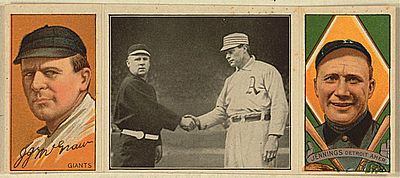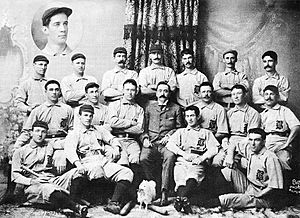Baltimore Orioles (1882–1899) facts for kids
| Full name | Baltimore Base Ball and Exhibition Company |
|---|---|
| Founded | 1882 |
| Folded | 1899 |
| League |
|
| Based in | Baltimore, Maryland |
| Ballpark |
|
| Colors | Orange/yellow/gold, black, white |
| Owner | Harry Von der Horst |
| Manager |
|
| League titles | 3 (1894, 1895, 1896) |
The Baltimore Orioles were a famous professional baseball team from the 1800s. They played from 1882 to 1899. First, they were part of the American Association. Later, they joined the National League.
This early Orioles team had many amazing players. Some of them later became members of the Baseball Hall of Fame. The team was very successful. They finished in first place for three years in a row, from 1894 to 1896. They also won the Temple Cup, which was like a national championship, in 1896 and 1897.
Even though they were very good, the Orioles team was removed from the National League after the 1899 season. The league decided to shrink from 12 teams down to eight. A few years later, in 1901, a new team called the Baltimore Orioles was formed. This team later moved to New York City and became the famous New York Yankees.
Contents
History of the Baltimore Orioles Baseball Team
The team was officially called the "Baltimore Base Ball and Exhibition Company." It started in 1882. They were one of the first teams in the American Association, which was a major baseball league back then.
After a few average years, the team left the league in 1889. But they came back in 1890 to replace another team. In 1892, the Orioles joined the National League. This is when the team started to become legendary.
In June 1892, Harry Von der Horst, the team owner, hired Ned Hanlon to be the manager. Ned Hanlon was given a lot of power over the team. He helped turn the Orioles into a winning team.
After two tough years, the Orioles became champions. They won three league titles in a row from 1894 to 1896. Many players on these teams later joined the Hall of Fame. They also won the Temple Cup in 1896 and 1897.
After the 1898 season, many of the star players and manager Ned Hanlon moved to the Brooklyn Dodgers. This happened because both teams had the same owners. Only John McGraw and Wilbert Robinson stayed in Baltimore. McGraw became the new player/manager.
In 1899, the Orioles finished in fourth place. After that season, the National League decided to cut down on the number of teams. The Baltimore Orioles were one of the teams that were removed. McGraw and Robinson then joined the St. Louis Cardinals.
A year later, John McGraw helped start a new league called the American League. He formed a new team in Baltimore in 1901. This new team was also called the Baltimore Orioles. However, they only stayed in Baltimore for two seasons. In 1903, they moved to New York. This team eventually became known as the New York Yankees.
Top-level professional baseball did not return to Baltimore until 1954. That's when the St. Louis Browns team moved to the city and became the modern-day Baltimore Orioles.
Orioles Home Ballparks
The Orioles played at a few different fields. From 1890 to 1891, they played at the old Oriole Park. This park was located in the Harwood area of Baltimore.
In 1891, the Orioles moved to Union Park. This park was a few blocks away from their old field. They played many famous games here. They won their three championships at Union Park from 1894 to 1896. The team played there until they were removed from the National League in 1899.
Star Players of the Orioles

The original Baltimore Orioles were one of the most famous teams in baseball history. They were managed by Ned Hanlon. They won league titles in 1894, 1895, and 1896.
The team had many colorful and talented players. Some of the most well-known were John McGraw, Wee Willie Keeler, Hughie Jennings, Joe Kelley, Wilbert Robinson, and Dan Brouthers.
These players were known for playing "scientific baseball." This was a smart way of playing the game before home runs became very common. It was similar to what is now called "small ball." This style of play focused on:
One special play they used was called the "Baltimore Chop." This is when a batter hits the ball hard into the ground. The ball bounces high into the air. This gives the batter time to reach first base safely before the other team can catch the ball.
Several Orioles pitchers also threw "no-hitters." A no-hitter is a game where a pitcher does not allow the other team to get any hits. Matt Kilroy threw one on October 6, 1886. Bill Hawke threw one on August 16, 1893. Jay Hughes threw a no-hitter on April 22, 1898.
Baseball Hall of Famers
Many players and managers from the 19th-century Baltimore Orioles team were so good that they were later inducted into the Baseball Hall of Fame.
| Baltimore Orioles Hall of Famers | |||
|---|---|---|---|
| Inductee | Position | Tenure | Inducted |
| Dan Brouthers | 1B | 1894–1895 | 1945 |
| Ned Hanlon | CF / Manager | 1892–1898 | 1996 |
| Hughie Jennings | SS/1B | 1893–1899 | 1945 |
| Willie Keeler | RF | 1894–1898 | 1939 |
| Joe Kelley | LF | 1892–1898 | 1971 |
| Joe McGinnity | P | 1899 | 1946 |
| John McGraw | 3B / Manager | 1891–1899 | 1937 |
| Wilbert Robinson | Catcher / Manager | 1890-1899 | 1945 |
See also
- History of the New York Yankees
- History of the Baltimore Orioles
- Inside Baseball


